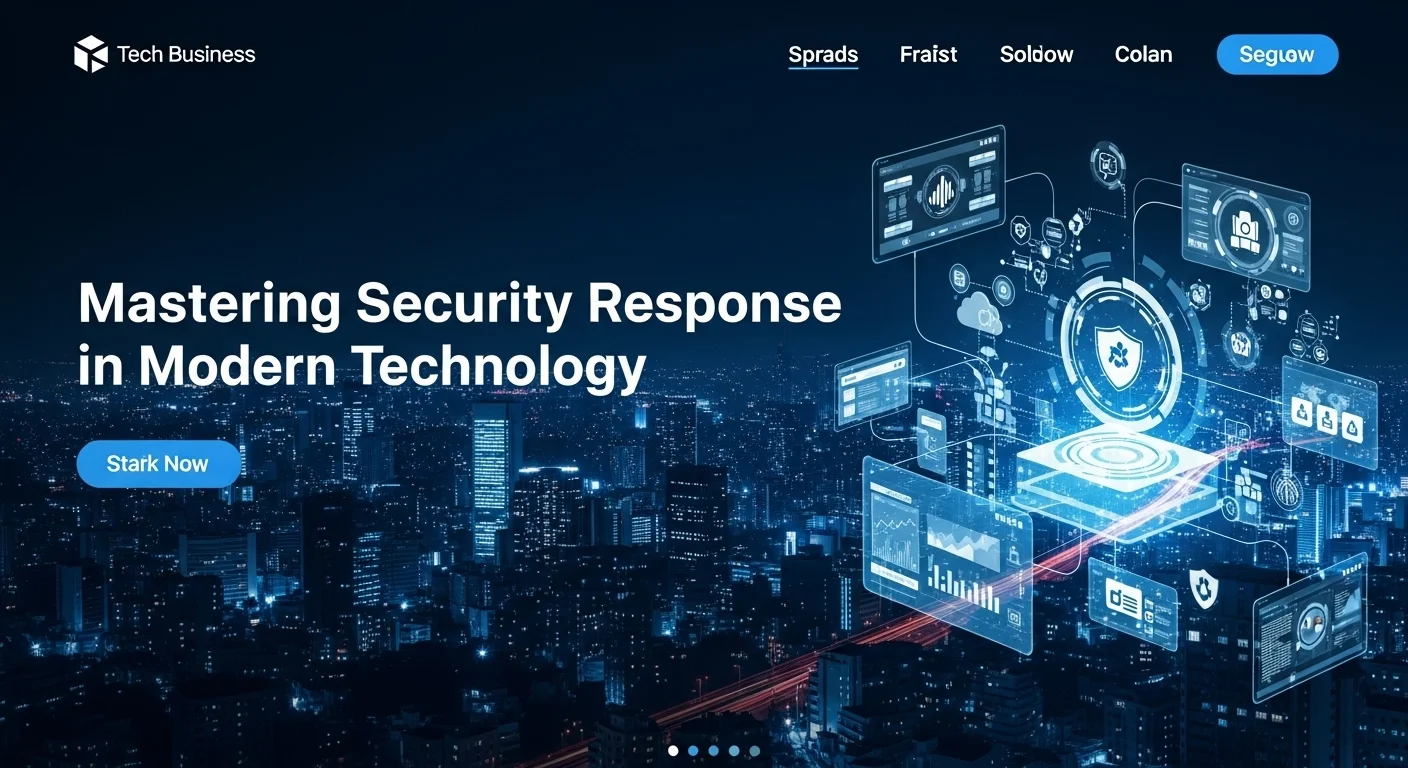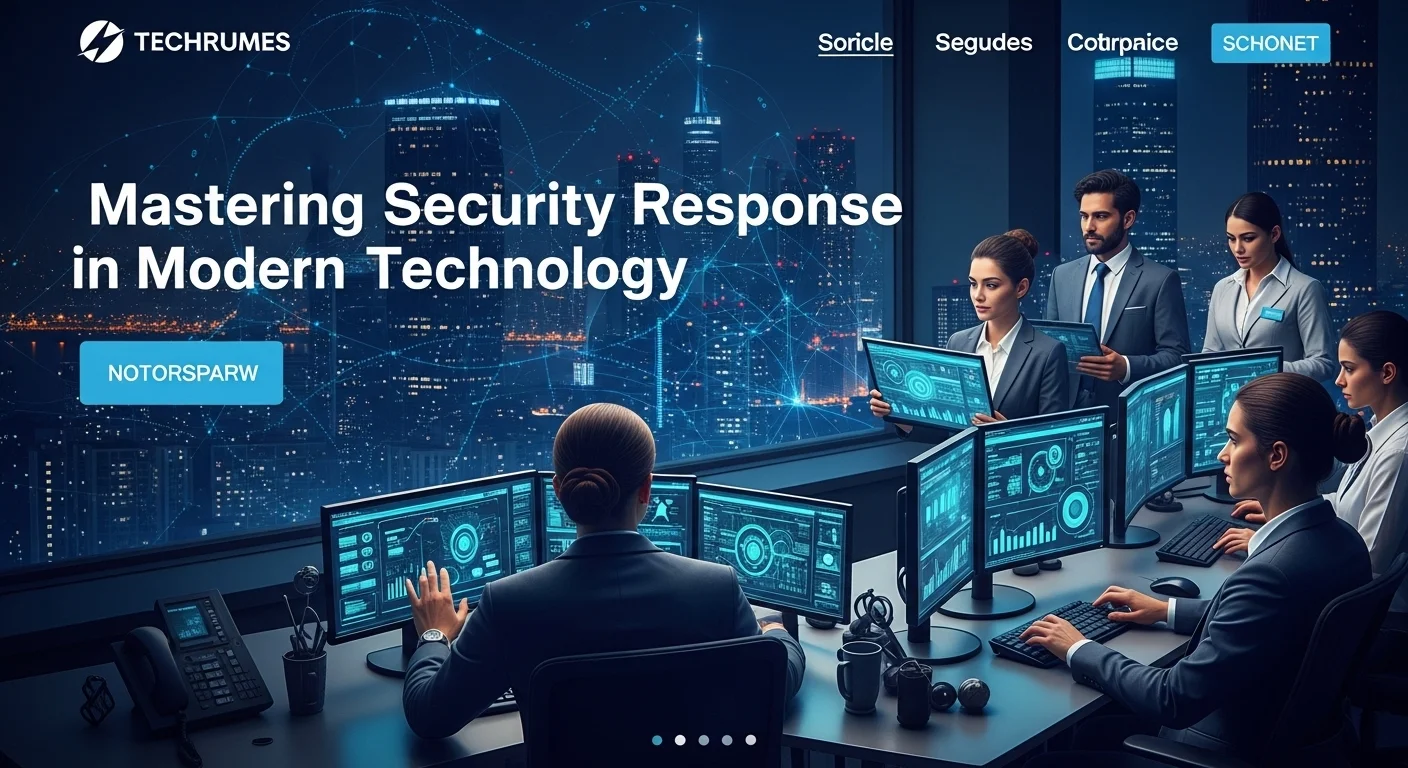Your Essential Guide to Security Response: Navigating Cyber Threats in Today's Tech World

Executive Summary
Let's be honest, in our hyper-connected world, it's not a matter of *if* you'll face a cyber threat, but *when*. That's where a solid Security Response plan comes in. It's more than just an IT checklist; it's your business's lifeline in a crisis. In this article, I'll walk you through what a real-world security response looks like, from preparing for the worst to recovering and learning from an attack. We’ll cover the nitty-gritty of handling incidents, the specific challenges of cloud security, and when it makes sense to call in the pros. Whether you're leading a business, working in IT, or just passionate about technology, you'll find practical insights here to help you build a more resilient defense against today's evolving threats.
Table of Contents
Table of Contents
- What is Security Response and Why is it so Critical?
- The Lifecycle of Incident Response: A Step-by-Step Approach
- Why Security Response is a Business Must-Have
What is Security Response and why is it so Critical?
In my years in cybersecurity, I've seen the term 'Security Response' move from the server room to the boardroom. So, what is it, really? In simple terms, Security Response is your organization's game plan for dealing with the chaos of a cyberattack or security breach. Think of it as the digital equivalent of a fire department's emergency plan. It’s not about just having firewalls; it’s about knowing exactly what to do when the alarm bells start ringing. This whole process is often called incident response in cyber security, and its main job is to put out the fire quickly, minimizing the damage, cost, and time it takes to get back on your feet. A good plan isn't just about reacting; it’s about making sure the same thing doesn't happen again.
The importance of having a solid security response plan today can't be overstated. We're all connected through cloud services, smart devices (IoT), and AI. These incredible technologies have opened up amazing possibilities, but they've also created a much bigger playground for attackers. I've seen firsthand how a slow or disorganized response to a threat can bring a company to its knees, leading to huge financial losses, a damaged reputation, and broken trust with customers. In this digital age, a fast and effective cyber security response isn't a luxury; it's a basic requirement for staying in business. It’s about protecting your most valuable information and keeping your operations running smoothly in the face of constant threats.
The Lifecycle of Incident Response: A Step-by-Step Approach
To bring order to the chaos of a security breach, we rely on proven frameworks. The most widely respected one comes from the National Institute of Standards and Technology (NIST). It breaks the process down into four phases that form a cycle: Preparation; Detection & Analysis; Containment, Eradication & Recovery; and Post-Incident Activity. The fact that it's a cycle is key—it means you're always learning and getting better at defending yourself.
1. Preparation: The Foundation of Resilience
I can't stress this enough: this is the most important phase. As the old saying goes, 'By failing to prepare, you are preparing to fail.' Preparation is everything you do *before* an incident happens. This means creating a formal Incident Response Plan (IRP) that clearly states who does what. You'll need to assemble your 'A-team'—a Computer Security Incident Response Team (CSIRT) with people from IT, security, legal, PR, and management. This is also where you get your tools ready, like Security Information and Event Management (SIEM) systems and forensic software. Most importantly, you need to practice. Running regular drills and simulations ensures your team doesn't freeze under pressure. A critical piece of the puzzle is having a communication plan ready for everyone from your CEO to your customers.
2. Detection and Analysis: Identifying the Threat
This phase kicks in the moment you suspect something is wrong. The goal here is to spot and confirm an actual security incident, figure out how bad it is, and understand its potential impact. It involves keeping a close eye on your networks and systems, looking for anything out of the ordinary. Your team will dig through logs and alerts to find clues, known as indicators of compromise (IOCs). Once you've found something, you have to figure out if it's a real threat or just a false alarm. This stage is all about prioritizing, so you can focus your energy on the biggest fires first. The better your visibility and the sharper your team's skills, the better you'll do here.
3. Containment, Eradication, and Recovery: Mitigating the Damage
Once you've confirmed an incident, the first priority is to stop the bleeding. Containment is all about preventing the threat from spreading further. This could mean taking affected systems offline or blocking a malicious IP address. After you've contained it, you move to eradication—getting rid of the threat completely. This might involve removing malware or patching the vulnerability that the attacker used. Finally, the recovery phase is about getting back to business as usual. You'll restore systems from clean backups and double-check that everything is secure before bringing it back online. The goal is to get back to normal as quickly and safely as possible.
4. Post-Incident Activity: Learning and Improving
Just because the incident is over doesn't mean the work is done. This final 'lessons learned' phase is what separates good teams from great ones. You hold a review meeting to talk about what happened, how the response went, and what could have been done better. This should be a no-blame meeting; the focus is on fixing process or technology gaps, not pointing fingers. The insights you gain are used to update your plan, improve your security, and make you stronger. This feedback loop is what makes information security incident response a process of continuous improvement, turning every incident into a learning opportunity.
Why Security Response is a Business Must-Have
In today's economy, your data is your treasure, and the tech that holds it is your fortress. A weak cyber security response can have devastating business consequences. The costs go beyond just fines or legal fees; they include lost business from downtime and the price of cleanup. But the damage to your company's reputation can be the most painful and lasting wound. Customers trust you with their data, and a breach shatters that trust. Furthermore, the game is always changing. With so many businesses moving to the cloud, cloud security incident response has become its own special skill. Responding to an incident in AWS or Azure is a different ballgame, involving shared responsibilities and unique tools. For companies without a dedicated security team, turning to professional cyber security incident response services is a smart move. These experts can parachute in during a crisis and help manage everything from containment to recovery. Ultimately, investing in security response isn't just an IT expense; it's an investment in your company's survival, resilience, and reputation in a very tough digital world.

A Complete Guide to Security Response in Technology and Business
A truly effective Security Response program isn't something you can just buy off a shelf. It's a living, breathing capability built on smart plans, skilled people, and the right technology. It’s about being both proactive and agile. Let's dive into the practical guide for building a top-tier security response program that can handle the challenges of modern business.
Assembling Your Cyber Security Incident Response Team (CSIRT)
At the end of the day, people are your most valuable asset in any incident response in cyber security effort. This core group, your Computer Security Incident Response Team (CSIRT), is your designated first responder. Whether you have one central team or experts distributed across the company, the key is to have crystal-clear roles. Here’s who you typically need on your A-team:
- Incident Commander: This is the general. They lead the response, make the tough calls, and coordinate everyone. Their job is to manage the crisis, not get lost in the technical weeds.
- Technical Lead: This is your senior tech expert who directs the hands-on containment and recovery work. They are the tactical genius behind the technical strategy.
- Security Analysts: These are your soldiers on the ground. They're the ones digging through data, analyzing malware, and implementing the fixes.
- Communications Lead: This person manages the story. They keep leadership informed, work with legal and PR, and handle the tough job of notifying customers or regulators.
- Legal Counsel: You need legal advice from the get-go to navigate regulations, liability, and evidence handling, especially when sensitive data is involved.
- Subject Matter Experts (SMEs): These are specialists you pull in from other departments—like your network engineers or app developers—when you need their specific expertise.
The Tools of the Trade: Your Technical Arsenal
A fast and effective cyber security response relies on great technology. A modern security operations center (SOC) is packed with tools that give you visibility and help you act fast. Here are the essentials:
- Security Information and Event Management (SIEM): Think of this as the central nervous system of your security. It collects and analyzes log data from everywhere—servers, networks, apps—to spot potential threats and send out alerts.
- Security Orchestration, Automation, and Response (SOAR): SOAR tools are the ultimate force multiplier. They take alerts from the SIEM and automate the initial response steps based on pre-built 'playbooks.' By handling repetitive tasks, SOAR frees up your human experts to focus on the hard stuff, dramatically speeding up response times.
- Endpoint Detection and Response (EDR): EDR tools are your eyes and ears on every computer and server. They watch for suspicious behavior, record everything, and allow you to remotely investigate and neutralize threats on a compromised machine.
- Network Detection and Response (NDR): NDR solutions watch the traffic flowing across your network to catch threats that might not show up on an endpoint, like an attacker moving from one system to another.
- Digital Forensics Tools: When you need to do a deep-dive investigation after an incident, these are the tools you use. They let you analyze a perfect copy of a hard drive or memory to piece together what an attacker did and gather evidence.
The Unique Challenge of Cloud Security Incident Response
Moving to the cloud has been a game-changer for business, but it's also created new headaches for incident response. A cloud security incident response plan has to account for the unique nature of the cloud:
- The Shared Responsibility Model: With the cloud, security is a partnership. Your provider (like AWS or Azure) secures the cloud infrastructure itself, but you are responsible for securing what you put *in* the cloud—your data, your settings, and who has access. Understanding this division is step one.
- No Physical Access: You can't just walk into a data center and grab a server anymore. Cloud forensics relies on APIs and specialized tools to capture digital evidence like snapshots of virtual disks.
- Dynamic and Ephemeral Resources: Things in the cloud, like containers, can be created and destroyed in seconds. This makes investigation tricky because evidence can vanish. This is why having robust, centralized logging is absolutely non-negotiable.
- Legal Headaches: Your data could be stored in different countries, creating a maze of data privacy laws and regulations that you have to navigate during an investigation.
- Using Cloud-Native Tools: The cloud providers give you powerful security tools (like AWS CloudTrail or Azure Sentinel). A smart cloud response strategy is built around using these tools to their full potential for detection and investigation.
In-House vs. Outsourced: Calling in the Pros
Building a 24/7 incident response team is a massive undertaking. For many businesses, it just isn't practical. This is where professional cyber security incident response services are a lifesaver. These firms offer expert help on retainer, so you have a team of pros ready to jump in when you need them. Deciding whether to build your own team or outsource is a big strategic choice:
Pros of an In-House Team:
- They know your business, your systems, and your people inside and out.
- They can often react faster to smaller, day-to-day incidents.
- You have complete control over the entire process.
Pros of Outsourced Services:
- You get instant access to a deep bench of specialists who have seen it all.
- It's often more cost-effective than staffing a full-time, round-the-clock team.
- They come with guaranteed response times and access to high-end tools you couldn't afford on your own.
- They provide a calm, third-party perspective in the middle of a crisis.
In my experience, a hybrid model works best for many. You have a small internal team for the initial triage and handling of minor issues, but you keep an external firm on retainer for the big, company-threatening incidents. This gives you the best of both worlds: daily coverage and world-class expertise for when you really need it, ensuring your information security incident response is always ready.

Pro Tips and Strategies to Elevate Your Security Response
An effective security response program isn't a one-and-done project; it’s a continuous effort that evolves with your business and the threat landscape. By adopting a proactive mindset and using modern strategies, you can turn your response from a frantic scramble into a smooth, controlled process. Here are some actionable tips from my experience in the trenches to enhance your information security incident response and create a more secure technology experience.
Embrace Proactive Best Practices
The best incident is the one that never happens. Being proactive means you're not just waiting for the alarm to go off; you're actively working to minimize the chances and impact of a breach.
- Develop Detailed Playbooks: A generic plan isn't enough. I always advise teams to create detailed 'playbooks' for specific, likely scenarios like a ransomware attack or a data breach. These should be step-by-step guides that tell your team exactly what to do, from technical procedures to communication templates. In a crisis, you don't want to be making things up as you go.
- Make Logging Your Religion: You can't respond to what you can't see. Ensure you're collecting detailed logs from all critical systems—endpoints, servers, and especially your cloud services. These logs are your primary evidence. Send them to a central, secure place like a SIEM where they can't be erased by an attacker and are easy to analyze.
- Live by the Principle of Least Privilege (PoLP): This is one of the most powerful yet simple security concepts. Give users and systems only the minimum access they need to do their jobs. It's a game-changer for containing breaches. If a user's account gets compromised, this principle severely limits how much damage the attacker can do.
- Pressure-Test Your Plan with Drills: An untested plan is just a theory. You have to test your incident response in cyber security plan regularly. Tabletop exercises, where you talk through a scenario, are great for finding gaps. For a real-world test, I'm a huge fan of purple teaming, where an attack team ('red team') tries to break in while your defense team ('blue team') tries to stop them. It’s the best practice you can get.
Leverage Automation and Artificial Intelligence
The speed and volume of modern attacks are too much for humans to handle alone. AI and automation are no longer 'nice-to-haves'; they are essential partners for any modern cyber security response team.
- Automate the Grunty Work: Use SOAR platforms to handle the initial, repetitive tasks. When an alert comes in, the SOAR can automatically check the reputation of an IP address, look up a file hash, and gather data from the affected machine. This gives your analysts instant context so they can make better decisions, faster.
- Use AI to See the Unseen: Old-school antivirus is dead. Modern security tools use machine learning to understand what 'normal' looks like in your environment. They can then spot subtle deviations that signal a sophisticated attack that traditional tools would miss.
- Embrace GenAI for Security: The new frontier is Generative AI, like Microsoft's Security Copilot, being built into security platforms. I've seen how these tools can act as an expert partner for every analyst. They can summarize complex incidents in plain English, suggest response steps, and even draft incident reports. This technology is a game-changer, set to dramatically boost the efficiency of security teams.
Mastering Cloud Security Incident Response
With business-critical operations running in the cloud, mastering cloud security incident response is mandatory. The old on-premise rules don't always apply.
- Automate Evidence Collection: The cloud is dynamic, so your forensic process must be automated. Set up scripts that, upon a high-severity alert, automatically snapshot a virtual machine's disk and memory, isolate it from the network, and save all the relevant logs before the evidence disappears.
- Know Your Enemy: Cloud-Specific Attacks: Prepare for threats unique to the cloud, like stolen API keys, leaky S3 buckets, or attacks on cloud metadata services. Your playbooks must be tailored to these specific cloud risks.
- Demand a Single Pane of Glass: If you use multiple clouds or a hybrid setup, you need security tools that give you a single, unified view across everything. Without it, you'll have blind spots that attackers will happily exploit.
Choosing and Managing Your Response Partners
For many, partnering with an outside expert is a smart strategic move. When you engage with cyber security incident response services, do it right:
- Get a Retainer Before You Need It: The worst time to find a response partner is during a five-alarm fire. Sign a retainer agreement beforehand. This way, you have a team that already knows you, with pre-agreed terms and guaranteed response times. It's cheaper and far more effective than a panic call.
- Check Their Credentials and Experience: Look for firms with a proven track record and certified experts. Ask for case studies from your industry. You want a partner who has handled your type of crisis before.
- Make Them Part of Your Team: Your external provider shouldn't be a stranger. Include their contact info and procedures in your plan. Involve them in your drills. When a real incident hits, you'll work together like a well-oiled machine.
By putting these strategies into practice, you can build true resilience. A mature security response program doesn't just cut the costs of an attack; it builds trust with your customers and gives you a powerful competitive advantage. For a deeper dive, the NIST Computer Security Incident Handling Guide (SP 800-61) is still the gold standard for building a formal program.
Expert Reviews & Testimonials
Sarah Johnson, Business Owner ⭐⭐⭐⭐
This was a great overview! As a small business owner, I'd love even more tips tailored for teams without a dedicated IT department. Still, very insightful!
Mike Chen, IT Consultant ⭐⭐⭐⭐⭐
As an IT consultant, I found this guide incredibly useful. It breaks down the NIST framework in a way that's easy to explain to clients. The section on cloud response was spot on.
Emma Davis, Tech Expert ⭐⭐⭐⭐⭐
Fantastic article! I've been specializing in cybersecurity, and this piece perfectly captures the human and business side of incident response, not just the tech. It's a must-read.



